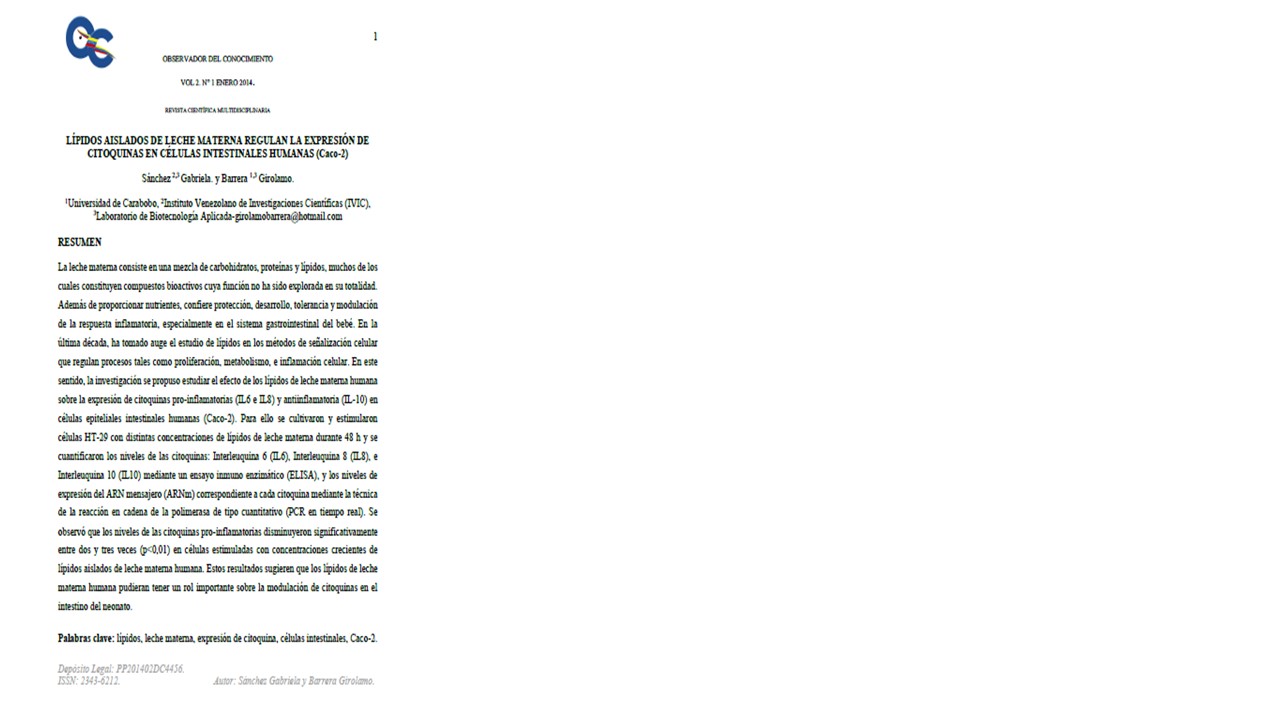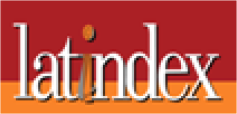Lipids Isolated from Breast Milk Regulate Cytokine Expression in Human Intestinal Cells (Caco-2)
Keywords:
Lipids, breast milk, cytokine expression, intestinal cells, CacoAbstract
Breast milk consists of a mixture of carbohydrates, proteins and lipids, many of which constitute bioactive compounds whose function has not been fully explored. In addition to providing nutrients, it confers protection, development, tolerance and modulation of the inflammatory response, especially in the baby's gastrointestinal system. In the last decade, the study of lipids in cell signaling methods that regulate processes such as cell proliferation, metabolism, and inflammation has gained momentum.
Downloads
References
Barrera, G.; Portillo, R.; Mijares, A.; Rocafull, M.; del Castillo, J.; Thomas. L.; (2009). Immunoglobulin A with protease activity secreted in human milk activates PAR-2 receptors, of intestinal epithelial cells HT-29, and promotes beta-defensin-2 expression. Immunology Letters, 123: 52–59.
Bernt K., Walker. W., (1999). Human milk as a carrier of biochemical messages. Acta Paediatr , 88(430):27-41(Suppl.)
Borniquel, S., Jansson, E., Marsha, P.; Bruce A.; Lundberg. J.; (2010). Nitrated oleic acid up-regulates PPARγ and attenuates experimental inflammatory bowel disease. Free Radical Biology & Medicine, 48: 499–505.
Chakravarthy, M., Lodhi, I., Yin, L.; Malapaka, R.; Xu, H.; Turk J.; Semenkovich. C.; (2009). Identification of a physiologically relevant endogenous ligand for PPARalpha in liver. Cell, 138: 476–488.
ESPGAN Committee on Nutrition. 1982. Guidelines on infant nutrition: III. Recommendations for infant feeding. Acta paediatrica Scandinavica; Vol. 302 : 1– 27 pp.
Fernández, I., De las Cuevas. I., (2006). Enterocolitis necrotizante neonatal. Boletín Pediátrico, 46(SUPL. 1): 172-178
Field, C. (2005). The Immunological Components of Human Milk and Their Effect on Immune Development in Infants. The Journal of Nutrition, 135(1):1-4.
Fleith, M., Clandinin. M. (2005). Dietary PUFA for preterm and term infants: review of clinical studies. Critical Reviews in Food Science and Nutrition, 45(3):205-229.
Folch, J., Lees M., Sloane. G., (1957). A simple method for the isolation and purification of total lipides from animals tissues. Journal of Biological Chemistry, 226: 497–509.
Fullekrug, W. Stremmel, G. Griffiths, R. Ehehalt. (2007). Anti-inflammatory effects of phosphatidylcholine. The Journal of Biological Chemistry, 282:27155–27164.
Innis, S. (2007). Human milk: maternal dietary lipids and infant development. Proceedings of the Nutrition Society, 66: 397–404.
Koletzko, B., Rodriguez-Palmero, M. Demmelmair, H., Fidler, Jensen, R., Sauerwald. T., (2001). Physiological aspects of human milk lipids. Early Human Development, 65: S3–S18 (Suppl.).
Lee, Y., Hwang, D., (2006). The Modulation of Inflammatory Gene Expression by Lipids: Mediation through Toll-like Receptors. Molecular Cells, 21(2):174-185.
Li, H., Black, P., Chokshi, A., Sandoval-Alvarez, A. Vatsyayan, R. Sealls W., DiRusso, C., (2008). High- throughput screening for fatty acid uptake inhibitors in humanized yeast identifies atypical antipsychotic drugs that cause dyslipidemias. Journal of Lipid Research, 49: 230-244.
Receptor Gamma Agonist Ligands Stimulate a Th2 Cytokine Response and Prevent Acute Colitis. Inflammatory Bowel Diseases, Vol. 8 (5) : 330–339 pp.
Saegusa, S. Totsuka, M. Kaminogawa S., Hosoi. T., (2007). Cyokine Responses of Intestinal Epithelial-Like Caco-2 Cells to Non Pathogenic and Oportunistic Pathogenic Yeast in the presence of Butyric Acid. Bioscience, Biotechnology, and Biochemistry, 71(10): 2428-2434.
Saubermann, L., Nakajima, A., Wada, K., Zhao, S., Terauchi, Y. Kadowaki, T. Aburatani, H. Matsuhashi, N. Nagai R., Blumberg. R., (2002). Peroxisome Proliferator- Activated
Schneider, H., Braun, A. Füllekrug, J. Stremmel W., Ehehalt. R., (2010). Lipid Based Therapy for Ulcerative Colitis: Modulation of Intestinal Mucus Membrane Phospholipids as a Tool to Influence Inflammation. International Journal of Molecular Sciences, 11: 4149-4164
Smit, E., Martini, I., Kemperman, R., Schaafsma, A. Muskiet F., Boersma. E. (2003). Fatty acids in formulae for term infants: compliance of present recommendations with the actual human milk fatty acid composition of geographically different populations. Acta Paediatr., 92(7):790-796.
Tillett, W., Francis. T., (1930). Serological reactions in pneumonia with a non-protein somatic fraction of pneumococcus. Journal of Experimental Medicine, 52:561-571.
Treede, I., Braun, A., Sparla, R., Kuhnel, M., Giese, T., Turner, J., Anes, H., Kulaksiz, J. Vilaplana, M., (2011).Nuevos nutrientes en leches infantiles. Ámbito farmacéutico, nutrición 30 (1): 46-52.
Wymann, M., Schneiter. R., (2008). Lipid signalling in disease. Nature Reviews Molecular Cell Biology 9: 162- 176.
Zhang, Q. y M. Wakelam. 2010. Chemistry and Physics of Lipids, 163: S7.

Downloads
Published
How to Cite
Issue
Section
License

This work is licensed under a Creative Commons Attribution-NoDerivatives 4.0 International License.







